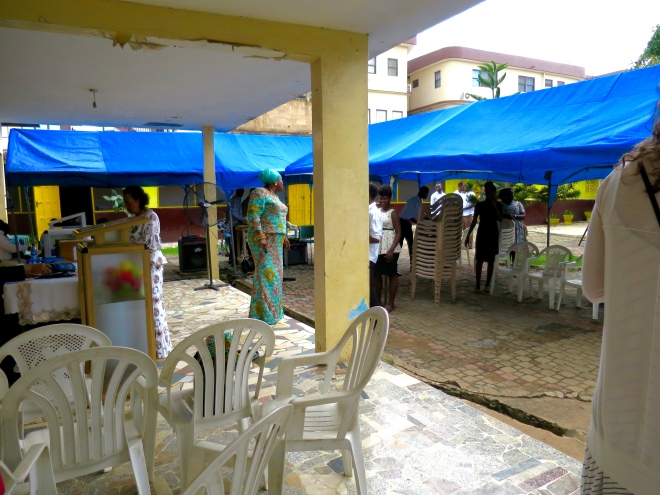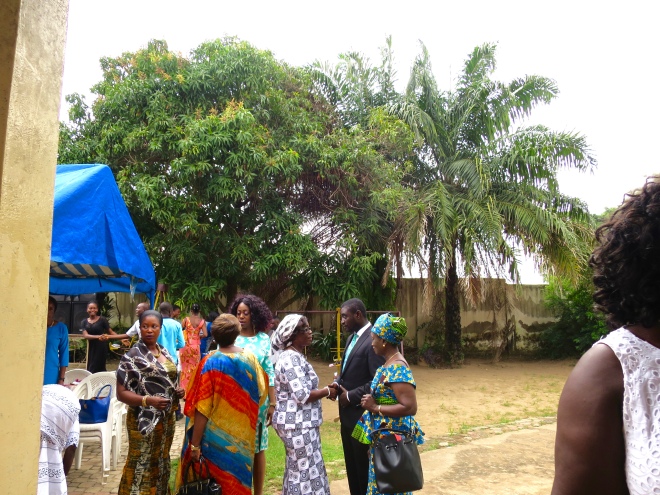
^One of my host brothers, PK, and me after church!
Just as a preface to this post, know that my observations of Ghana’s religious practices form just a fraction of the religious reality here. I’ve been primarily exposed to Christian practices in Accra, and so my post will focus on my experiences thus far.

^The back of a trotro wearing the phrase “Trust God.” It is not uncommon for trotros and taxis to have such religious sayings adorning the windows.
Overview
Ghana is a primarily Christian country, though the Northern region has a larger Muslim population. From my observations thus far, some traditional Ghanaian religious elements merge with Christian ones to form a dynamic belief system. These beliefs, coupled with the popularity of Christianity, make for an extremely religious society.
I’ve witnessed the everyday popularity of Christianity a couple of times at the clinic. I brought the staff a little present from home, just a bag of hazelnuts. When I presented it to a nurse, she immediately expressed her gratitude, held up the gift, said a prayer of thanks, and ended with a passionate “Amen!” from her and the other nurses. And another day, I saw a nurse playing on her phone. I asked what she was looking at, and she joyfully presented me with a slide show of pictures of Jesus. I have to admit, her excitement about the Jesus slide show was a bit infectious. 🙂
My Church Experience

^The road outside of church. If you look closely, on the left hand side of the road, there’s a sign reading “Presbyterian Church of Ghana.” The stand is outside of the English/ French/ Ga church.
I observed a service at the Presbyterian Church of Ghana, my host family’s church. There are multiple branches of this church in Accra, and we attended the English/ Twi service (as compared to the English/ French/ Ga service). Mass took place outside of someone’s house, I believe, underneath tents and the house’s veranda.
The congregation was primarily older, with some younger people and families present as well. Kids went to a classroom to do their own thing, like listen to songs and read their own versions of that day’s pertinent Bible passages.
Church here usually takes around four hours, from 9 am to 1 pm. My family, like typical Ghanaians, arrived at 10 pm, a whole hour late! I don’t think we missed a ton though; it seemed like that first hour was devoted to song. The music set up was interesting: some young people (including one of my host brothers!) had microphones, and there was a keyboardist, a guitarist, and a drummer. Basically a lil band! I couldn’t help but notice that people sang much more heartily than at Catholic masses I’ve attended back home.
The service was organized as such: songs, discussion groups, hymns, bible passages, the pastor’s homily/ sermon, welcoming of visitors, celebration of birthdays, general announcements, donations, communion, and a closing song. Whew! Just a few more elements than what I’m used to. So, now to break the different sections down!
Discussion groups:
I really enjoyed this element! Each group was given discussion questions that related to that week’s theme. The week I attended, the theme happened to be sin (at least I think. I just know they talked about sin a whole lot). The discussions lasted for about 30 minutes. Although my group primarily discussed in Twi, every now and again they would pause and summarize sentiments for me in English.
Bible passages and Sermon:
I’m thinking these two sections account for mass’s length. The bible passages and the sermon were given in both English and Twi. The sermon, lasting for about 30-40 minutes, felt a bit more formal/ stiff compared to the Catholic homilies I’ve heard (or maybe I’ve just heard homilies from pretty chill priests). This sermon heavily emphasized sin and the rejection of sin. What caught my particular interest was his mention of the sin of same-sex marriages. I knew that same-sex marriages are illegal in Ghana and that society here is largely intolerant of homosexuality, but it still caught me off guard.

^A view from my position during church. They maintained the cross shape seating arrangement, even in the outdoor venue!
Welcoming of Visitors:
Boy, were they welcoming! That was hardly a surprise, though, as the spirit of welcoming is an important social custom in Ghana. Here, it is standard to hear “You are welcome” or “Akwaaba” when entering a space. (The lack of welcome is seen as an offense.) So, it was hardly a surprise to learn that the church welcomed visitors with a similar enthusiasm. They invited all visitors to the front of church, and the elders of the church shook all of the visitors’ hands and welcomed us.
Donations:
The process of donations seemed to exert far more peer pressure than what I’m used to. The donation bins, all arranged on a large cross, were placed at the front of the congregation. One by one, people proceeded to the bins to make their donations. It became pretty obvious who did and did not donate. That being said, though, people seemed quite excited to get up, shuffle to the front, and do their part to improve their church.
Communion:
At first, I wasn’t sure if I was allowed to receive communion. I know I can receive communion at Catholic services, but I wasn’t sure how Presbyterians do things. But after confirming that I’m Christian, a few elders urged me to take communion. I guess being Christian is all it takes! The wine administration was pretty different from what I’m used to as well. They served it in little, individual cups, almost like mini shot glasses!

^Some churchgoers talking after mass. The ladies tended to wear traditional Ghanaian patterns and styles.
Of course, this is but a brief overview of my observations of religious practices in Ghana. There are many more complexities, especially when taking the traditional Ghanaian religious beliefs and presence of Islam into account. And while the blatant popularity of Christianity here, in all aspects of life, catches me off guard sometimes, I can see why some call it a pop culture movement. Its relevance across all age groups and pervasiveness into daily life, from praising hazelnuts to Jesus slide shows, certainly makes it pop. 😛
Love your blog. G&G
LikeLike
So interesting to hear about Ghanaian religious practices and how their beliefs manifest in everyday life!
LikeLike
Love your descriptive writing! Thanks again for sharing your perspective on this part of Ghanaian life.
LikeLike
One must be very dedicated to endure a 4-hour service. I like the idea of the shot glass. Much more sanitary than everyone slugging off the same chalice.
LikeLike